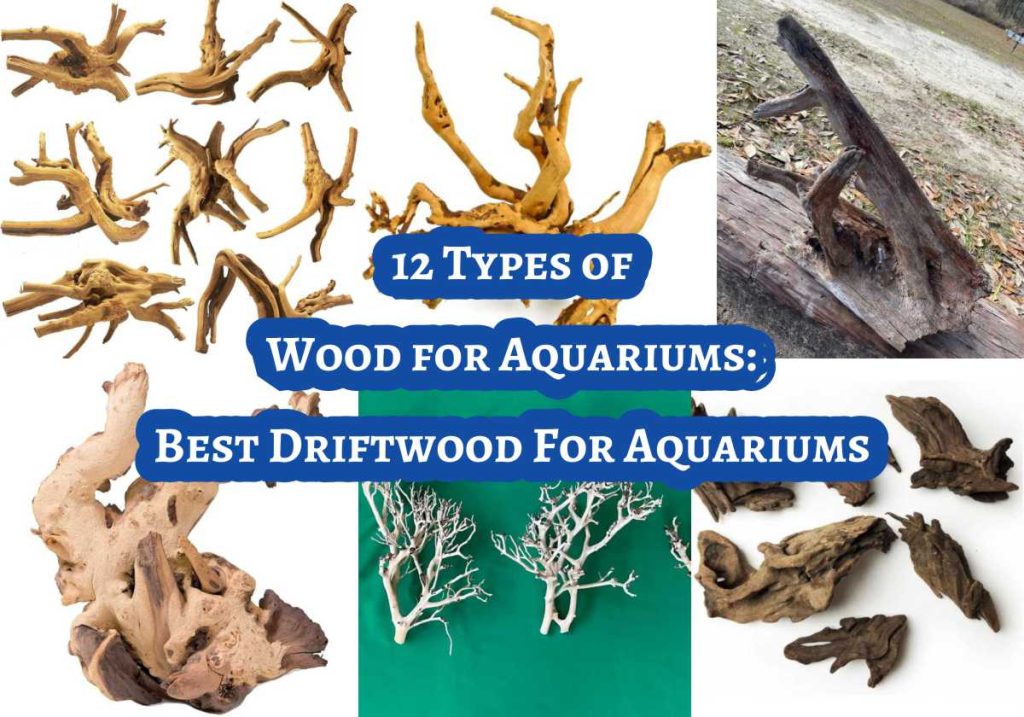As an Affiliate, We may earn a commission that doesn't cost you extra from qualifying purchases using links in this post. It helps keeps this blog running.
An aquarium or fish tank is that enchanting realm where nature’s wonders are brought to life within the glass confines of your living space. If you’re an aquarium enthusiast, you already understand the significance of every element within your tank. And one such element that can transform your aquatic wonderland into a mesmerizing masterpiece is driftwood.
Driftwood, with its rugged charm and intriguing textures, is’t just an aesthetic addition; it’s a vital component that can elevate your aquarium’s health and appearance. In this article, we’ll dive deep into the world of varying aquarium wood types. Together we’ll explore the various types of driftwood available, delve into the benefits they offer, and equip you with the knowledge needed to select, prepare, and maintain driftwood for your aquatic haven.
So, whether you’re a seasoned aquarist looking to refresh your tank’s decor or a beginner embarking on a watery adventure, stay tuned as I uncover the secrets of driftwood and discover how it can take your fish tank to new depths of beauty and vitality.
To navigate this aquatic journey successfully, you need to understand the various wood types available and how each can contribute to the well-being of your aquarium’s residents. So, let’s dive right in and discover the fascinating world of wood in aquariums, uncovering the secrets to creating a stunning and thriving underwater world.
12 Types Of Driftwood For Aquariums and Fish Tanks
Driftwood not only adds a touch of natural beauty to your aquarium but also provides a functional and safe environment for your aquatic friends. However, not all driftwood is created equal. So, let’s explore the types that are suitable for your aquarium.
1. Malaysian Driftwood
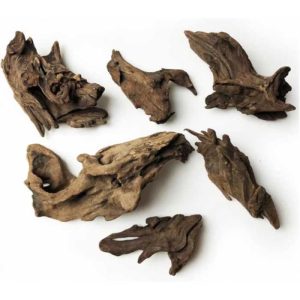
Malaysian driftwood originates from the tropical rainforests of Malaysia, Malaysian driftwood is a popular choice amongst several types of wood for aquariums and fish tanks. Its characteristic dark brown color and intricate branching patterns create a stunning focal point in your aquarium.
The gnarled and twisted appearance of Malaysian driftwood provides natural hiding spots for your fish and a perfect surface for beneficial algae growth. Plus, it releases tannins that can create a natural, slightly tinted water, replicating the conditions of many tropical habitats. Which then helps to lower pH levels for certain fish species that prefer slightly acidic water, like tetras and discus.
2. Mopani Driftwood
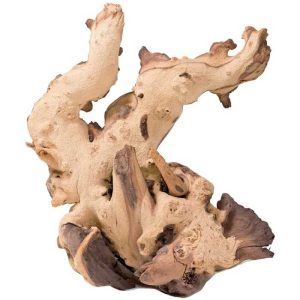
Amongst the different types of aquarium wood is the Mopani driftwood. Hailing from the banks of the Zambezi River in Africa, Mopani driftwood boasts a unique two-toned coloration. Its dark, almost ebony, exterior gradually fades to a light, sandy interior, making it a visually striking addition to your tank. Its dense nature makes it sink easily, and it’s resistant to decay, making it a long-lasting addition to your aquarium. The smooth, polished surface adds a touch of elegance to your aquatic environment. Mopani driftwood also aids in maintaining water quality by absorbing impurities and softening water, benefitting fish that prefer slightly acidic conditions. This aquarium wood also has intricate shapes that provide plenty of hiding spots for fish and create an engaging environment.
3. Spider Wood (Azalea Wood)

For a truly exotic touch to your aquarium, look no further than Spider Wood, originating from Southeast Asia. Spider wood, often referred to as Azalea wood, is known for its distinctive branching structures that resemble the legs of a spider. Its name stems from the intricate web-like appearance created by its long, slender branches.
Even though there are numerous types of wood for aquarium, this driftwood is a favorite among aquascapers for its artistic and otherworldly appeal. It not only offers a visually striking focal point but also provides an interesting playground and hiding spots for fish, shrimps, and other aquarium pets. Its twisted branches create a captivating landscape for your fish to explore, while the airy structure promotes water circulation and oxygenation.
4. Manzanita Driftwood
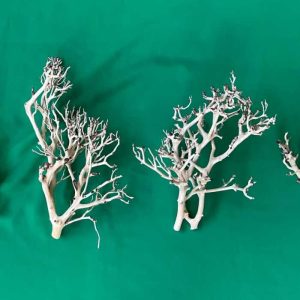
Hailing from the arid regions of California and the southwestern United States, Manzanita driftwood showcases a rugged yet elegant appearance. Its twisted and contorted branches resemble miniature works of art, making it a favorite among aquascaping enthusiasts. Manzanita driftwood is an aquarium safe wood types that is light in color, which can provide a stunning contrast when placed against dark substrates. Its dense and hard nature makes it long-lasting in aquatic environments, and its intricate shapes create intriguing underwater landscapes for your fish to explore.
5. African Bogwood

Straight from the heart of Africa’s riverbanks, African bogwood is a classic choice that offers a unique blend of ancient history and natural beauty. This Aquarium wood is often aged for centuries by water and soil, giving it a rich, dark color and a weathered, textured appearance. Its intricate knots, twists, and crevices create an otherworldly atmosphere in your aquarium. African bogwood not only serves as an attractive centerpiece but also helps in maintaining water hardness and stability by releasing tannins as it ages which affects the aquarium water pH, making it a valuable addition for fish that prefer slightly acidic water conditions.
6. Oak Driftwood
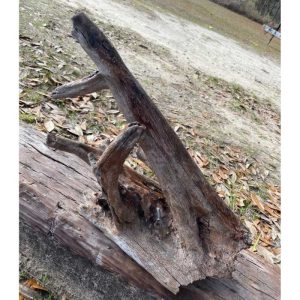
Oak driftwood is also one of the different types of aquarium wood that is sourced from oak trees and brings a touch of sophistication to your aquarium. Its woodgrain patterns and earthy tones add a classic charm to your underwater landscape. Oak driftwood is a robust choice, resistant to decay, and capable of withstanding the test of time in your aquarium. Using the Oak driftwood as an aquarium wood will help your fish tank water maintain its water quality by providing a surface for beneficial bacteria to colonize, promoting a balanced ecosystem.
7. Cypress Knees
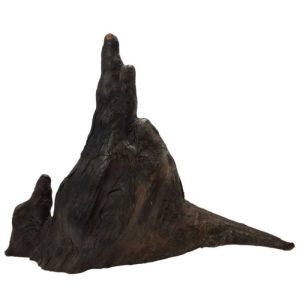
When making decisions about different types of wood for aquarium, you should consider Cypress knees, as they are the unique roots of the cypress tree found in the swamps and wetlands of the southern United States. Their peculiar shape, resembling knobby, knee-like structures, adds an intriguing, rustic element to your aquarium. These fish tank wood pieces provide natural hiding spots and anchor points for aquatic plants, creating a harmonious environment for your aquatic life. Cypress knees wood types for aquarium are lightweight and float initially but will become waterlogged over time, making them ideal for pet fish owners looking to craft one of a kind fish tank landscapes.
8. Bonsai Driftwood
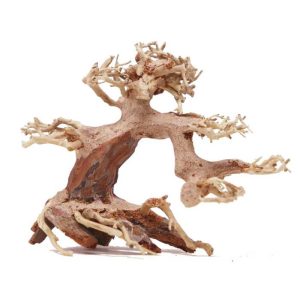
For a fusion of artistry and nature, consider Bonsai driftwood wood types for aquariums. These miniature trees are meticulously crafted from driftwood pieces, often resembling iconic Bonsai styles. Their compact size and intricate branches offer a unique focal point in small aquariums or nano tanks. Bonsai driftwood can be planted with aquatic mosses and plants, adding an artistic touch to your underwater garden while also providing shelter for small fish and invertebrates.
9. Cholla Wood
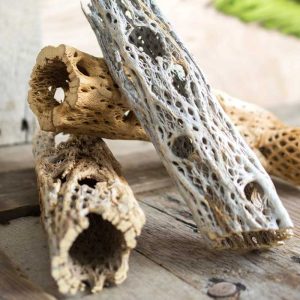
Cholla wood, derived from the skeleton of the Cholla cactus, is a popular option for shrimp keepers amongst the several different types of aquarium wood. Cholla wood offers a unique, porous structure that is excellent for shrimp tanks and small aquariums. Its porous nature provides a surface for biofilm to grow, which is a natural food source for shrimp.
Cholla wood also has hollowed-out tubes that not only offer hiding spots for molting shrimp but also promote beneficial algae growth for grazing. This hallowed appearance also adds an intriguing desert-like element to your tank.
Not to mention that the Cholla driftwood releases minimal tannins, making it an excellent choice for aquarists aiming to maintain water clarity.
10. Grapevine Driftwood
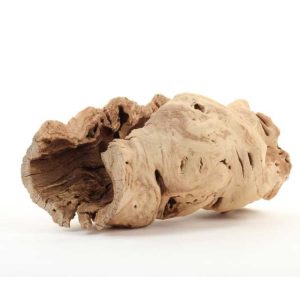
Grapevine driftwood is a natural beauty from California’s vineyards and is known for its distinctive, twisting and winding branches, that resemble the vines of a grapevine. Its intricate, curving forms lend a sense of age and mystique to your aquarium. The open structure of the Grapevine wood types for aquariums allows for easy attachment of plants and mosses, enhancing the aesthetics of your aquatic habitat while also providing ample space for fish to explore and seek shelter. Grapevine driftwood not only serves as a great playground for fish but it’s also great for other aquarium invertebrates to swim through and hide in.
11. Willow Root Driftwood

Also included in this list of different types of wood for aquarium is the Willow root driftwood, which is often found in the form of intricate root systems, brings a sense of natural complexity to your aquarium. Its intricate roots create a maze-like structure that offers both aesthetic appeal and a labyrinth for fish to navigate. This wood is particularly suitable for smaller fish tanks where its detailed features can shine.
12. Red Moor Wood

Red Moor wood, originating from Europe, is prized for its reddish-brown coloration and unique shapes. It can lend a warm and earthy tone to your aquarium, making it an excellent choice for biotope setups. The nooks and crannies in Red Moor Wood provide hiding spots for fish and create an enticing environment for breeding or simply observing your aquatic pets.
How To Identify Types Of Driftwood
Although different types of Driftwood can reveal fascinating tales of their own. But first, we need to learn how to identify the various types of driftwood.
- Size and Shape Matters:
One of the simplest ways to begin identifying driftwood is by considering its size and shape. Driftwood comes in various sizes, from small twigs to massive logs. Pay attention to the overall form – is it long and slender or short and stout? These characteristics can give you a clue about the type of tree it came from and how long it’s been adrift.
- Texture and Smoothness:
Next, feel the surface of the driftwood. Is it rough and jagged or smooth as silk? Texture can reveal a lot about the wood’s journey. Smooth, polished surfaces suggest prolonged exposure to water and weathering, while rough textures may indicate fresher finds.
- Color Spectrum:
The color of driftwood can also be a key identifier. Coastal driftwood often has a bleached, sun-bleached appearance due to exposure to saltwater and sunlight. Inland driftwood, on the other hand, tends to retain more of its original wood color.
- Wood Grain and Knots:
Take a closer look at the wood grain patterns and any knots present. Each tree species has unique grain patterns and knot formations. By identifying these features, you can narrow down the possibilities of the tree species the driftwood originated from.
- Density and Weight:
Weight is another useful factor in driftwood identification. Heavier pieces may indicate denser wood, which is typically hardwood. Lighter driftwood is often softer and comes from coniferous trees. Consider these weight differences as you explore the world of driftwood.
- Smell the Story:
Yes, driftwood can have its own distinct odor. Give it a whiff – does it have a salty, oceanic scent, or is it more earthy and woody? The smell can be a telltale sign of its origin and journey.
Importance Of Driftwood: Highlighting The Significance Of Driftwood In Aquariums.
So, why is choosing the right type of wood for your aquarium so crucial? Well, think of it as selecting the perfect furniture for your dream home. The right choice of aquarium safe wood types enhances the beauty and functionality of your living space, while the wrong one can lead to discomfort and chaos. Similarly, the wrong type of wood in your aquarium can disrupt its harmony and adversely affect the health of your aquatic companions.
So, let’s dive into the importance of driftwood and highlight how it can transform your aquatic environment into a thriving, picturesque ecosystem.
1. Natural Aesthetics: Driftwood’s charm lies in its rustic, natural appearance. When placed in an aquarium, it mimics the look of submerged wood in a natural aquatic habitat. The earthy tones and irregular shapes add a touch of authenticity to your tank, making it visually pleasing for both you and your aquatic pets. Aquarium safe wood types provides the perfect backdrop for your aquatic plants, fish, and other inhabitants, creating a beautiful underwater landscape.
2. pH Regulation: Aquarium woods aren’t just about aesthetics; they also play a crucial role in maintaining water chemistry. Most Aquarium wood is made from hardwood, which contains tannins. These tannins leach into the water, gradually lowering the pH levels. This natural pH reduction can be especially beneficial for aquariums that house fish species that thrive in slightly acidic water conditions. It can help create a more comfortable and stable environment for your aquatic friends.
3. Natural Hideaways: Fish love a bit of privacy now and then, and driftwood offers them the perfect hiding spots. Many fish species, such as plecos and cichlids, enjoy seeking refuge among the nooks and crannies of driftwood. It provides a sense of security and reduces stress, ultimately contributing to the overall well-being of your fish.
4. Surface Area for Beneficial Bacteria: Driftwood isn’t just a place for fish to hide; it also serves as a substrate for beneficial bacteria to colonize. These bacteria play a vital role in breaking down organic matter and maintaining water quality. The textured surface of driftwood provides an ideal habitat for these bacteria to thrive, helping to keep your aquarium water clean and healthy.
5. Algae Control: Another benefit of Aquarium wood is its ability to inhibit the growth of undesirable algae. As the Aquarium wood releases tannins into the water, it can create water conditions that are less conducive to algae growth. This means less maintenance for you and a more visually appealing aquarium for everyone to enjoy.
6. Natural Diet Enhancement: Some herbivorous fish species, may graze on the biofilm and microorganisms that grow on the surface of driftwood. This additional food source can supplement their diet and contribute to their overall health.
Selecting the Right Driftwood: Considerations for Choosing the Best Piece
Selecting the right driftwood for your fish aquarium can be a bit overwhelming with the wide variety of options available. Notwithstanding, this is an important decision that can greatly influence the overall aesthetics and functionality of your fish’s home. If you carefully take into consideration important factors such as size, type, preparation, texture, compatibility, and maintenance when choosing aquascape wood types, you can make an informed choice that will keep both your fish and your aquarium plants happy.
- Size Matters:
The first thing to consider when choosing driftwood for your aquarium is its size. You want to ensure it fits comfortably within your tank without overcrowding. Measure the available space in your aquarium and choose a piece of driftwood that complements the dimensions. Remember, your fish need enough room to swim and explore around the driftwood without feeling cramped.
- Type of Driftwood:
Different types of driftwood are available, and each can create a unique aesthetic in your aquarium. The most common types include Mopani wood, Malaysian driftwood, and Spider wood. Research the characteristics of each type to determine which one aligns best with your desired aquarium theme and the needs of your fish.
- Preparing and Curing:
Before adding driftwood to your aquarium, it’s essential to prepare and cure it properly to ensure it won’t harm your fish or alter the water chemistry. This process involves soaking the driftwood in water and periodically changing the water until it no longer releases tannins or other potentially harmful compounds. The curing process can take several weeks, so plan accordingly.
- Texture and Appearance:
Consider the texture and appearance of the driftwood when making your choice amongst the several types of wood for aquarium. Some aquascape wood types may have intricate twists and turns, while others have smoother surfaces. Think about how the texture and shape will enhance the visual appeal of your aquarium and provide hiding spots for your fish.
- Compatibility with Fish and Plants:
Certain fish species prefer specific types of driftwood. For instance, African Cichlids are known to love Mopani wood, while Amazonian fish thrive among Malaysian driftwood. Also, consider whether you plan to incorporate live plants into your aquarium, as some driftwood may affect plant growth.
- Maintenance and Cleaning:
Driftwood, like any other aquarium decor, requires regular maintenance. Some types of driftwood may develop algae growth, so be prepared to clean it periodically to maintain its appearance and ensure it doesn’t affect water quality.
- Budget Considerations:
Driftwood can vary widely in price depending on its type, size, and source. Before making your final decision, set a budget for your aquarium decor and stick to it. Remember that you don’t have to break the bank to find a suitable and visually appealing piece of driftwood. Shop around at local pet stores, and online retailers, or even consider DIY options if you’re feeling creative.
Frequently Asked Questions (FAQ)
Is it safe to use driftwood from natural sources?
Yes, you can use driftwood from natural sources but it must be properly prepared, soaked, and sterilized to remove any potential contaminants.
Do I need to anchor driftwood in my aquarium?
Your driftwood might initially float in your aquarium, so it’s recommended to anchor driftwood to the bottom of the tank to prevent it from floating until it becomes waterlogged.
How can I prevent algae from growing on driftwood?
You can prevent Algae from growing on your fish tank driftwood by controlling lighting, maintaining good water quality, or considering adding algae eating species to your tank.
How often should I replace driftwood in my aquarium?
You should replace the driftwood in your aquarium if it becomes rotten or begins to disintegrate, typically every few years.
Can driftwood affect my aquarium’s water parameters?
Driftwood may slightly lower pH and soften water, which can be beneficial for certain fish species.
Do I need to remove fish during driftwood placement or maintenance?
Removing your fish while placing aquarium wood in your tank is unnecessary, but be cautious to avoid stressing your fish during the process.
Can I use driftwood in a saltwater aquarium?
Yes, you can use driftwood in a saltwater aquarium, but select driftwood that is suitable for marine environments and won’t affect water chemistry negatively.
Are there any fish or aquatic species that specifically benefit from driftwood?
Yes, certain fish like Plecos and shrimp love and benefit from driftwood for grazing and hiding, making it an excellent addition to their habitat.
How do I maintain driftwood in my aquarium?
You can maintain your aquarium wood by regularly inspecting it for decay or algae growth. If necessary, remove, clean, or replace it to maintain water quality.

I’m Akin Bouchard. Even though I now own several different fish species, I first became a koi pond owner because I loved these creatures and wanted to turn my passion into something more serious. I take pride in my collection of koi fish and love sharing my knowledge with others interested in these beautiful creatures.

